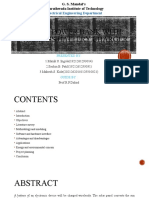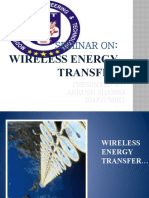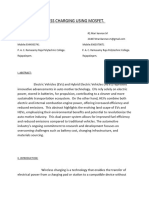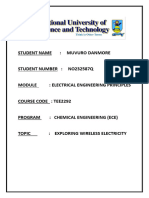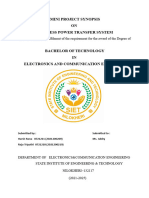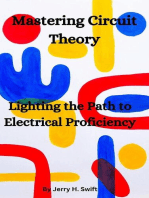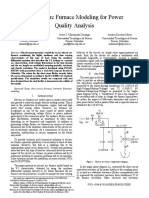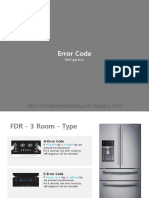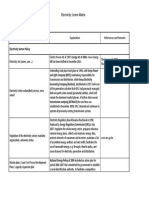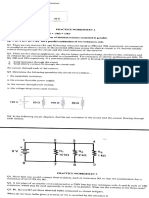Wireless Charging
Wireless Charging
Uploaded by
suraj RCopyright:
Available Formats
Wireless Charging
Wireless Charging
Uploaded by
suraj ROriginal Title
Copyright
Available Formats
Share this document
Did you find this document useful?
Is this content inappropriate?
Copyright:
Available Formats
Wireless Charging
Wireless Charging
Uploaded by
suraj RCopyright:
Available Formats
Project Abstract
Project title: Wireless charger using two n channel MOSFETS IRF 540,4148 diodes
Student’s Name with USN Bharat Kumar
1JB16EE005
SJBIT
Academic Supervisor REKHA P S
Industrial Supervisor
Keywords: Wireless Power Transfer Technology, Electric Vehicles, Frequency.
SYNOPSIS
ABSTRACT:
Wireless charging is a technology of transmitting power through an air gap to electrical devices
for the purpose of energy replenishment. The recent progress in wireless charging techniques and
development of commercial products have provided a promising alternative way to address the
energy bottleneck of conventionally portable battery-powered devices. However, the
incorporation of wireless charging into the existing wireless communication systems also brings
along a series of challenging issues with regard to implementation, scheduling, and power
management. In this paper, we present a comprehensive overview of wireless charging
techniques, the developments in technical standards, and their recent advances in network
applications.
INTRODUCTION:
Emerging technologies are making our life simpler these days. With the introduction of
mobile phones, life has changed rapidly. This is a dream of radio engineering. Mobile
phones merged land line telephone systems. These days, many advancements in the
mobile phones were introduced.
These advancements provide many services such as text, internet etc. But although there
Dept of EEE, SJBIT Page 1
Project Abstract
are many advancements in the technology, we still rely on the wired battery chargers. Each
phone will have its own designed battery charger. Thus the battery chargers are required to
carry everywhere to keep the battery backup. When you sit for tea and place your mobile on the
table,it simply charges your mobile. This article explains a simple wireless battery charger circuit
that charges your mobile when placed near the transmitter. This circuit may be used as wireless
power transfer circuit, wireless mobile charger circuit, wireless battery charger
circuit, etc.
Wireless Battery Charger Circuit Principle:
This circuit mainly works on the principle of mutual inductance. Power is transferred from
transmitter to the receiver wirelessly based on the principle of •ginductive coupling•h.
Inductance is the property of the conductor, in which the current flowing in a conductor
induces a voltage or electromotive force in it or in another nearby conductor. There are two
types inductance. 1) Self inductance, 2)Mutual Inductance.
Dept of EEE, SJBIT Page 2
Project Abstract
Wireless Power Transfer Circuit Diagram:
Wireless battery charger circuit design is very simple and easy. These circuits require only
resistors, capacitors, diodes, Voltage regulator, copper coils and Transformer.
In our Wireless battery charger, we use two circuits. The first circuit is transmitter circuit
used to produce voltage wirelessly. The transmitter circuit consists of DC source, oscillator
circuit and a transmitter coil. oscillator circuit consists of two n channel MOSFETS IRF 540
, 4148 diodes. When the DC power is given to the oscillator, current starts flowing through
the two coils L1, L2 and drain terminal of the transistor. At the same time some voltage is
appeared at the gate terminals of the transistors.
Dept of EEE, SJBIT Page 3
Project Abstract
In the second circuit that is receiver circuit consists of receiver coil, rectifier circuit and
regulator.
WORKING:
Broadly speaking, there are three types of wireless charging, according to David Green, a
research manager with IHS Markit. There are charging pads that use tightly-coupled
electromagnetic inductive or non-radiative charging; charging bowls or through-surface type
chargers that use loosely-coupled or radiative electromagnetic resonant charging that can
transmit a charge a few centimeters; and uncoupled radio frequency (RF) wireless charging that
allows a trickle charging capability at distances of many feet.
Both tightly coupled inductive and loosely-coupled resonant charging operate on the same
principle of physics: a time-varying magnetic field induces a current in a closed loop of wire.
It works like this: A magnetic loop antenna (copper coil) is used to create an oscillating magnetic
field, which can create a current in one or more receiver antennas. If the appropriate capacitance
is added so that the loops resonate at the same frequency, the amount of induced current in the
receivers increases.
REFERENCES:
1). R. Lomas, The Man Who Invented the Twentieth Century: Nikola Tesla Forgotten Genius of
Electricity, USA, CA, Los Angeles:CreateSpace Independent Publishing Platform, pp. 146,
1999.
2). J. C. Schuder, H. E. Stephenson, I. F. Townsend, "High-level electromagnetic energy transfer
through a closed chest wall", Proc. IRE Int. Conf. Record, vol. 9, pp. 119-126, 1961.
Dept of EEE, SJBIT Page 4
Project Abstract
Dept of EEE, SJBIT Page 5
Project Abstract
Dept of EEE, SJBIT Page 6
Project Abstract
Dept of EEE, SJBIT Page 7
Project Abstract
Dept of EEE, SJBIT Page 8
You might also like
- Solar Power Bank With Wireless Battery Project-1Document26 pagesSolar Power Bank With Wireless Battery Project-1Mahesh KaleNo ratings yet
- REVO VM IV 3.6-10kw HybridDocument2 pagesREVO VM IV 3.6-10kw HybridfarrelsyafiraNo ratings yet
- Project Proposal: Wireless Mobile ChargerDocument13 pagesProject Proposal: Wireless Mobile ChargerJerin TasnimNo ratings yet
- AIM:-Wireless Power Transmission: Page - 1Document19 pagesAIM:-Wireless Power Transmission: Page - 1prerna ojhaNo ratings yet
- 12th Phy Project FinalDocument16 pages12th Phy Project Finalanirudhas708No ratings yet
- GODDocument19 pagesGODjonathan akpogumaNo ratings yet
- Wireless ChargingDocument31 pagesWireless ChargingAbhinav Raj100% (1)
- Report Project.: Wireless ChargingDocument7 pagesReport Project.: Wireless ChargingWAQAR ALINo ratings yet
- What Is Wireless Battery ChargingDocument4 pagesWhat Is Wireless Battery Charginglsaty123No ratings yet
- Seminar On: Wireless Energy TransferDocument30 pagesSeminar On: Wireless Energy TransferKomal MahajanNo ratings yet
- ON Wireless Power TransmissionDocument18 pagesON Wireless Power TransmissionKarthik KolleNo ratings yet
- A 170415062631 PDFDocument18 pagesA 170415062631 PDFManisha SakkarwalNo ratings yet
- Wireless Mobile Battery Charger CircuitDocument4 pagesWireless Mobile Battery Charger Circuitparmard717800% (1)
- Government Polytechnic Amravat Electronics and TelecommunicatonsDocument17 pagesGovernment Polytechnic Amravat Electronics and TelecommunicatonsAbhijeetNo ratings yet
- Wireless Power Transfer Report PDFDocument25 pagesWireless Power Transfer Report PDFMaitri Shah100% (1)
- Undergraduate Application Based Research: Design and Testing of Wireless Phone ChargerDocument9 pagesUndergraduate Application Based Research: Design and Testing of Wireless Phone Chargergshadrack21No ratings yet
- Wireless Power TransferDocument13 pagesWireless Power TransferPonnampet Grama PanchayatNo ratings yet
- Ossai Chapter 2Document14 pagesOssai Chapter 2Ossai IsraelNo ratings yet
- Wireless Mobile ChargerDocument6 pagesWireless Mobile Charger22001007059No ratings yet
- Mergepresentation CholadeckDocument18 pagesMergepresentation Choladecksreehari952006No ratings yet
- Wireless Power Transfer Project Report (DE)Document10 pagesWireless Power Transfer Project Report (DE)Asmita shravan chavanNo ratings yet
- Wireless Battery ChargerDocument22 pagesWireless Battery ChargerAvinashreddy 9490665077100% (1)
- FCRAR2012 InductiveChargingDocument7 pagesFCRAR2012 InductiveChargingMuhammed HussainNo ratings yet
- Wireless Mobile Charger 2Document6 pagesWireless Mobile Charger 222001007059No ratings yet
- Wireless Charger PPDocument4 pagesWireless Charger PPHarshitha HarshuNo ratings yet
- akshit projectDocument25 pagesakshit projectSaurabh KumarNo ratings yet
- Wireless ChargingDocument24 pagesWireless ChargingVarun SahaniNo ratings yet
- Electricity Through Wireless Transmission - Development and PossibilityDocument8 pagesElectricity Through Wireless Transmission - Development and PossibilitySai ChandhraNo ratings yet
- Wireless Power TransmissionDocument36 pagesWireless Power TransmissionNelarapuMaheshNo ratings yet
- Presentation PPT Group No 6 NewDocument25 pagesPresentation PPT Group No 6 Newtushartekam675No ratings yet
- Wireless Solar Mobile Charger: Prof. Sara AnjumDocument4 pagesWireless Solar Mobile Charger: Prof. Sara AnjumNavya AdduriNo ratings yet
- Wireless ChargingDocument20 pagesWireless ChargingRagini. P 016No ratings yet
- Dokumen - Tips Wireless Charging PPT 58aa23692f972Document19 pagesDokumen - Tips Wireless Charging PPT 58aa23692f9724A7 SYAMPAVANNo ratings yet
- Dubex Semina ProposalDocument18 pagesDubex Semina Proposalannamichelle1001No ratings yet
- Wa0006.Document7 pagesWa0006.224033yogeshpadmanaban.jNo ratings yet
- Wireless Power Transmission1Document33 pagesWireless Power Transmission1positive69positiveNo ratings yet
- B WPT 1 PDFDocument20 pagesB WPT 1 PDFnirmala M.S.No ratings yet
- Charging StationDocument7 pagesCharging Stationzia khanNo ratings yet
- Wireless Electric Charging VehicleDocument16 pagesWireless Electric Charging VehicleGovindaraj RajNo ratings yet
- Wireless Battery ChargerDocument17 pagesWireless Battery ChargerVinukonda snehaNo ratings yet
- N0232587Q Muvuro DanmoreDocument8 pagesN0232587Q Muvuro DanmoredanmoremuvuroNo ratings yet
- Wireless Mobile Battery Charger Circuit PDFDocument4 pagesWireless Mobile Battery Charger Circuit PDFMariusz KaźmierczakNo ratings yet
- WPTS 2Document6 pagesWPTS 21521Ghanshyam PatilNo ratings yet
- Wireless Energy TransmissionDocument8 pagesWireless Energy TransmissionIRJMETS JOURNALNo ratings yet
- Wan JofuDocument27 pagesWan JofuFrancis OtienoNo ratings yet
- Ijetae 0314 119 PDFDocument4 pagesIjetae 0314 119 PDFprakashNo ratings yet
- Wireless Recharging/Transmission Technology: Submitted by C Somaskhandan MBA-1 Year Vgsom IIT KharagpurDocument13 pagesWireless Recharging/Transmission Technology: Submitted by C Somaskhandan MBA-1 Year Vgsom IIT Kharagpurcater101No ratings yet
- Electricity Through Wireless Transmission - Development and PossibilityDocument9 pagesElectricity Through Wireless Transmission - Development and PossibilitySuresh PanchalNo ratings yet
- Seminar 1Document17 pagesSeminar 1Durgaprasad DasNo ratings yet
- Project Synopsis-1Document7 pagesProject Synopsis-1h00141418No ratings yet
- Ibrahim ProjectDocument11 pagesIbrahim Projectrocketdy11No ratings yet
- Wireless Power Transfer Circuit and Its WorkingDocument4 pagesWireless Power Transfer Circuit and Its Workingpetchimuthu87No ratings yet
- Wireless Electricity With Home AutomationDocument4 pagesWireless Electricity With Home Automationjulian narvaezNo ratings yet
- Wireless Mobile Charger Using Inductive Coupling: October 2017Document17 pagesWireless Mobile Charger Using Inductive Coupling: October 2017Jerin TasnimNo ratings yet
- Bachelor of Technology IN Electrical Engineering Submitted by Arghyarupa PandaDocument19 pagesBachelor of Technology IN Electrical Engineering Submitted by Arghyarupa PandaDebayani MishraNo ratings yet
- WPT_Detailed_15_Page_ProjectDocument3 pagesWPT_Detailed_15_Page_Projectr17782112No ratings yet
- Wireless ChargingDocument2 pagesWireless ChargingShereen LinaNo ratings yet
- Physics Investigatory ProjectDocument21 pagesPhysics Investigatory Projectsinghdaksh287No ratings yet
- Introduction to Electronic Circuits: Unlocking the Power of ElectricityFrom EverandIntroduction to Electronic Circuits: Unlocking the Power of ElectricityNo ratings yet
- Electric Arc Furnace ModelingDocument6 pagesElectric Arc Furnace ModelingDanialMdNoorNo ratings yet
- Codigos de Error Refrigeradores Samsung Inverter Modelos FDR-?Document47 pagesCodigos de Error Refrigeradores Samsung Inverter Modelos FDR-?Clarita CheroNo ratings yet
- Kenya - Electricity Sector Matrix (2014)Document12 pagesKenya - Electricity Sector Matrix (2014)Detlef LoyNo ratings yet
- Tech Lab - Experiment 1 - Study of Electronics ComponentsDocument10 pagesTech Lab - Experiment 1 - Study of Electronics ComponentsAmrit JenaNo ratings yet
- On Grid Inverter 3 6KWDocument2 pagesOn Grid Inverter 3 6KWVăn ST QuangNo ratings yet
- Adobe Scan 19-Oct-2024Document1 pageAdobe Scan 19-Oct-2024rachna77rachnaNo ratings yet
- TC512 ManualDocument56 pagesTC512 ManualMARGARITA HERNANDEZ MIXTECONo ratings yet
- Tariffs and Load Curves (Module-2) : Presenter: Harshit Srivastava Aditya Srivastava Sparsh GuptaDocument24 pagesTariffs and Load Curves (Module-2) : Presenter: Harshit Srivastava Aditya Srivastava Sparsh GuptaAditya SrivastavaNo ratings yet
- Lemma For Electric Vehicle ChargingDocument34 pagesLemma For Electric Vehicle ChargingRamon ColonNo ratings yet
- Simulation Software For Power System Studies: Power Research & Development Consultants Pvt. LTDDocument4 pagesSimulation Software For Power System Studies: Power Research & Development Consultants Pvt. LTDRahul_KittuNo ratings yet
- Earthing Protection SpecificationDocument5 pagesEarthing Protection SpecificationNi ReNo ratings yet
- 2018 Sanwa enDocument33 pages2018 Sanwa enRebeca VargasNo ratings yet
- 01 - E1c13s A-4Document6 pages01 - E1c13s A-4at.flak88No ratings yet
- Types of Overcurrent Relays and Their ApplicationDocument3 pagesTypes of Overcurrent Relays and Their ApplicationAshraf HussienNo ratings yet
- ACVC Material PDFDocument75 pagesACVC Material PDFramakrishnaprasad908No ratings yet
- Assignment in Power SystemDocument5 pagesAssignment in Power SystemRhiza NavallascaNo ratings yet
- Lumina Homes PDFDocument1 pageLumina Homes PDFDestre Tima-anNo ratings yet
- TLE 9 4th QuarterDocument15 pagesTLE 9 4th QuarterMELAIDA CASTANAR GARIBAYNo ratings yet
- Zero-Sequence Overvoltage Protection Full PaperDocument6 pagesZero-Sequence Overvoltage Protection Full Paperprbthapa2055No ratings yet
- Power Saving of Packeged AC-2Document22 pagesPower Saving of Packeged AC-2Văn Long NguyênNo ratings yet
- Resumen Datos de Diseño UNAHDocument218 pagesResumen Datos de Diseño UNAHValeria Solórzano GabarreteNo ratings yet
- 2013 DM Cover 1Document19 pages2013 DM Cover 1gantasri8100% (1)
- System Neutral GroundingDocument4 pagesSystem Neutral GroundingVENKATESAN RNo ratings yet
- Brochure For Electrical Design Engineering Oil Gas PDFDocument10 pagesBrochure For Electrical Design Engineering Oil Gas PDFNaveen YallapuNo ratings yet
- TST D2Document20 pagesTST D2francisco uribeNo ratings yet
- 1Mhz 1A Synchronous Step-Down Regulator: Features General DescriptionDocument2 pages1Mhz 1A Synchronous Step-Down Regulator: Features General DescriptionM. M.No ratings yet
- ETU 776 TripDocument1 pageETU 776 TripbhaskarinvuNo ratings yet
- EEE361 Experiment 1 - IntroductionDocument4 pagesEEE361 Experiment 1 - IntroductionAtakan Yegen100% (1)
- Burner Control Unit BCU 440: Technical Information GBDocument37 pagesBurner Control Unit BCU 440: Technical Information GBjose luizNo ratings yet
